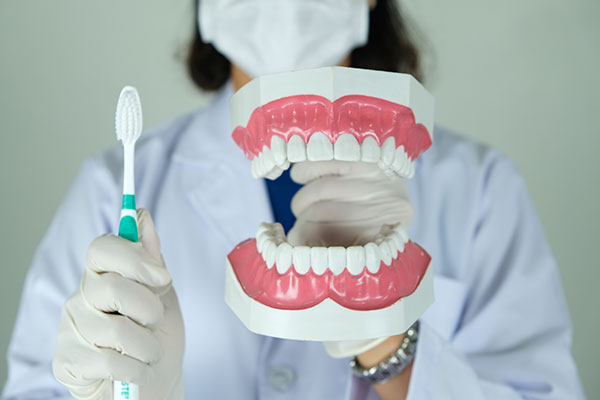3 Ways To Take Care of Your Dental Bridge

Dental bridges are a non-invasive restorative option for replacing missing teeth. However, they require proper care and maintenance to maintain the bridge and the surrounding teeth and gums. A general dentist can provide personalized instructions on caring for one’s bridge according to its type, location in the mouth, and other factors. However, patients can get a head start by learning the basics of caring for a dental bridge.
What is a dental bridge?
A general dentist can replace one to several missing teeth with a dental bridge: a framework of one or more artificial teeth (pontics) anchored to natural teeth or dental implants on either side of the gap. Depending on the type of bridge, the dentist will anchor them with dental crowns or resin-bonded metal wings. Each type is custom-made to match the shape, size, and color of surrounding teeth for a natural-looking restoration.
Although there are many tooth replacements to choose from, dental bridges remain popular due to their non-invasive nature. They not only improve the aesthetics of a smile but also restore important oral functions, such as chewing and speaking. Further, they help prevent remaining teeth from shifting out of place, lowering the patient’s risk of developing bite problems and losing more teeth.
Ways to take care of your dental bridge
Caring for a dental bridge requires good oral hygiene and some dietary considerations. For the sake of bridge longevity, patients should also continue to see their general dentist every six months for a checkup. Below, explore these three basics of dental bridge care in greater detail.
Practice good oral hygiene
Daily brushing and flossing are essential for overall oral health, and they are just as important for keeping a dental bridge clean and free of plaque. Brushing twice daily with fluoride toothpaste helps remove food particles and bacteria, improving the condition of both the bridge and the surrounding natural teeth or implants. To avoid damaging the bridge, use a soft toothbrush and do not brush too vigorously.
Plaque can also accumulate underneath the bridge. To prevent plaque buildup, floss under and around this area. Patients may find it helpful to use floss threaders or interdental brushes when cleaning these hard-to-reach areas.
Maintain a balanced diet
A nutritious diet supports oral health and the longevity of a dental bridge. Foods rich in calcium and vitamin D strengthen teeth and bones, while crunchy fruits and vegetables stimulate saliva production. A healthy amount of saliva helps wash away harmful bacteria; drinking plenty of water throughout the day has the same effect. Lastly, avoiding hard, sticky, or excessively sugary foods is recommended, as these can damage the bridge or increase tooth decay risk.
Keep regular dental appointments
Visiting a general dentist every six months for a dental checkup and cleaning promotes good oral health. The dentist can clear away plaque and tartar, keeping the teeth in good shape. For a similar reason, six-month checkups remain important after getting a dental bridge. During these appointments, the dentist will take care to examine the bridge and supporting teeth to ensure there are no signs of damage, decay, or infection.
Just like how dentists look for cavities during dental checkups, they will look for any potential issues like a broken or loose bridge. Detecting and addressing these issues early can extend the life of the bridge. In addition, dentists can also recommend specific tools or techniques to enhance at-home care, ensuring the bridge remains functional and comfortable.
What else to know about dental bridges
When should you see a dentist about a loose or broken bridge?
It is important to consult a dentist as soon as the patient notices any problems with their dental bridge. It is not always a good idea to wait until the next six-month checkup to ask a dentist about bridge discomfort, looseness, or visible damage. Instead, call the dental office and ask if the issue requires an appointment between checkups.
Replacing bridges
Dental bridges are durable, but they are not indestructible. Thus, bridges may need to be replaced over time due to wear or changes in the mouth. Common examples of such changes include gum recession, shifting teeth, or severe damage to the bridge.
Call a general dentist today
Dental bridges can last anywhere from five to 15 years. The better patients care for them, the longer they can last. Call our team at Dental Studio Colleyville to learn more about bridges and their care and maintenance.
Request an appointment here: https://dentalstudiocolleyville.com or call Dental Studio Colleyville at (817) 885-5188 for an appointment in our Colleyville office.
Check out what others are saying about our services on Yelp: Read our Yelp reviews.
Recent Posts
Think you might need a dental bridge? Read on to learn more about this restoration. According to the National Institute of Craniofacial and Dental Research, adults aged 20–64 have an average of three decayed or missing teeth. A dental bridge is among the most important restorative dentistry procedures, helping to restore optimal dental health and…
A CEREC dentist uses advanced dental technology to give patients high-quality restorations in a single appointment. This technology is revolutionizing the way crowns, veneers, and other dental restorations are made. If you value efficiency, precision, and convenience, working with a CEREC dentist can transform your dental care experience.CEREC, which stands for Chairside Economical Restoration of…
A CEREC dentist uses advanced technology to provide quick, effective treatments that restore damaged teeth. CEREC, which stands for Chairside Economical Restoration of Esthetic Ceramics, allows dentists to create dental restorations like crowns, veneers, and fillings in just one visit. This modern approach eliminates the need for messy impressions and multiple appointments, saving time while…
A traditional crown is often placed on a damaged or troubled tooth throughout two dental visits, but a CEREC® crown can be placed in one day. The acronym CEREC stands for Chairside Economical Restorations of Esthetic Ceramic, and these restorations provide a protective cap over a tooth the same way traditional crowns do. However, the…


